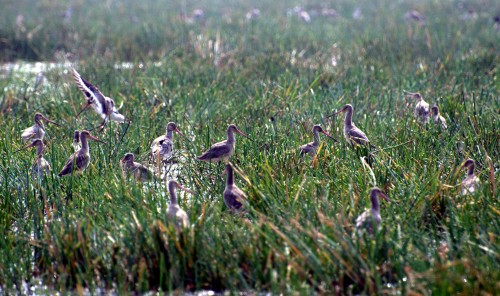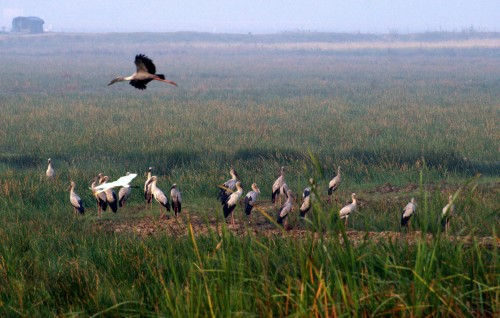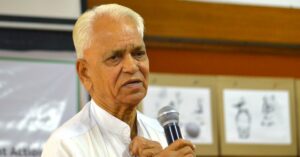Mangalajodi: A Village of Bird Protectors in Orissa
“Black-tailed godwits,” said my companion, pointing to a swirling cloud of specks in the distance that alternately turned black and silver white. A few hundred birds circled and zigzagged above
“Black-tailed godwits,” said my companion, pointing to a swirling cloud of specks in the distance that alternately turned black and silver white. A few hundred birds circled and zigzagged above the marshes, their black and off-white plumage creating the effect of being two entirely different species.
I was at Mangalajodi village, at the north-western edge of the great Chilika lagoon in Orissa. An hour’s drive from Bhubaneshwar, Mangalajodi’s large stretches of marshes, reed beds, and open water harbour tens of thousands of migrant and resident birds, protected by the villagers.
Madhu Behera, my guide, directed my gaze skywards. A v-formation of Openbilled storks was passing overhead. This species is abundant here, co-inhabiting the marshes with grazing buffalos, even congregating near the village in the evenings. I asked Madhu if he used to shoot this species also; he grinned, nodded, and said, “We ate everything. Not a bird was left 10-12 years back.”
Behaviour change
Therein lies a remarkable story of behaviour change. A decade back, Mangalajodi was a village of bird catchers. Virtually all species were trapped or shot, to eat or sell. It was a lucrative business, yielding up to Rs. 30,000 a month for some people. There was little that wildlife authorities could do. Till a NGO, Wild Orissa, stepped in. In 1996, along with some concerned villagers, it began to talk about possible protection efforts. With the use of cultural and ethical arguments, the attitude began to change. A Sri Sri Mahavir Pakshi Suraksha Samiti (Bird Protection Committee) was constituted by the village in 2000. Its efforts have almost completely eliminated bird poaching here and some ex-hunters like Madhu have become die-hard conservationists. In 2007, the state government awarded the Biju Pattnaik Award for Wildlife Conservation to the Samiti.
Suddenly, Madhav Behera, another guide, pointed excitedly to a clump or reeds. “Yellow bittern,” he said. Strain as I might, I could not see it…till it moved. It had been in full view, but so brilliantly merged with the grassy background it might as well not have been there. Even as I trained my binoculars on it, I was startled by the sudden swuuuush of 100 Pin-tail ducks rising from the marshes to our side. In the distance, a flock of Greylag geese circled and settled on some open water.
Mangalajodi’s checklist of birds numbers well over 200. Many of these are migratory, coming in such large numbers that the spectacle here in winter is comparable to the famed Bharatpur in its heyday. Interestingly, though, unlike protected areas like Bharatpur, local people inMangalajodi continue to fish and graze their buffalos in the wetlands. There is little indication that these have had a negative impact. As is now acknowledged, closure of Bharatpur to buffalo grazing in the early 1980s allowed grasslands to take over, and had to be kept in check by opening up the area to grass cutting and other methods. Villagers complain that fish catch has gone down, blaming siltation from surrounding degraded catchments and inaction by the government with regard to dredging the lagoon.
Madhu mentions that there are “over 100” fishing cats in the area. I am not quite sure how he has arrived at this estimate, but it may not be far off the mark. Members of the Samiti (having grown from the original 6-7 to about 25) patrol the wetland along its bunds and on boat, especially at night. They keep an almost constant count of numbers of what they see (including nests and eggs in the season). They have even set up four guard camps. These strategies, say the Samiti members, are much more effective than the recently set up camps by the Forest Department. The local forester I met confirmed that, were it not for the villagers, protection would be impossible.
As we start back towards the village, Golden plovers and Indian pratincoles shift uneasily on a bund we are passing. Beyond them, Purple moorhens display their brilliant plumage, competing with the dazzling Bronze-winged jacanas. As we get off the boat, I notice an Open-billed stork on the other side of the bund; I try to approach it silently to get a close-up, but it flies off. Laughing, my companions tell me that the birds are much shyer of outsiders than of the locals.
As I prepare to depart, a Samiti member gets a call from Nandkishore Bhujbal of Wild Orissa. A case of bird poisoning has been detected in a neighbouring village, and he is proceeding there with forest officials. Madhu Behera decides to accompany him and current Samiti president Ramhari Behera remarks that committees in the neighbouring villages are not as strong as Mangalajodi’s. Effective empowerment of communities and forest officials to deal with poaching is clearly needed, with Mangalajodi’s example as an inspiration.
What of the future?
I make the payment fixed for visitors by the Samiti as part of a fledgling ecotourism initiative. Wild Orissa has trained some youth as birding guides, and Chilika DevelopmentAuthority has funded a watchtower and visitors’ centre.
Is the income adequate for their livelihoods? They mention that some youth are getting a small monthly allowance from Wild Orissa, but this most probably ended in 2009. So what about the future? They are uncertain, and ask for help in increasing the number of genuine bird lovers visiting the village. They are also aware, however, that mass tourism could destroy the area. Alternative livelihoods? Not sure. Iwonder why the money going to forest department staff cannot go to village youth insituations where they have demonstrated effective conservation results. Before I can voice this, Madhu quietly says, “Whatever happens, our commitment to protecting these birds is not going to diminish.”
This story made me
- 97
- 121
- 89
- 167















